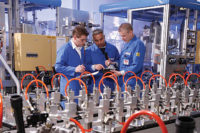It isn’t exactly news—manufacturing production lines are heading back to the States en masse, but there aren’t enough trained techs ready to staff them. Baby Boomers—our proverbial Old Guard—are retiring, leaving unfilled jobs for the unskilled—and some say uninterested—masses.
President Obama has launched a multimillion-dollar endeavor to address this through developing apprenticeships and job-training programs, and as such, manufacturing organizations, schools and businesses across the country are joining arms to try to shrink this skills gap.
TECH TIPSIn-Demand Skills Include:
Ways to Get a Competent Workforce
|
For example, the Northeastern Wisconsin (NEW) Manufacturing Alliance promotes manufacturing training and focuses on recruitment through early outreach programs. Andy Bushmaker, senior human resources manager at Green Bay-based KI Furniture (a member of the Alliance) echoes the sentiment that the manufacturing needs to be seen as sexier—and made more accessible— to up-and-coming generations if it wants to get hiring traction. To this end, Bushmaker and colleagues at the Alliance have created videos that local teachers are using to show how math and software is used on the production line.
While the manufacturing world grapples with recruitment, it’s also tasked with retainment challenges. As quality control becomes more prized, it’s taking center stage in production—changing how manufacturing is executed and keeping line workers on their toes.
“The function of quality control, while once a lagging indicator at the end of the production, is now being redistributed throughout the production process and is increasingly used for ‘go/no-go’ analysis or monitoring processes at critical steps,” says Bill Fetter, director of communications at Hexagon Metrology. ”This means that not only are additional skilled workers needed, but current tech’s jobs are changing, especially as quality control is reprioritized in the production process.”
Just what can be done to solve this persistent skills gap? In a recent interview with Quality, Fetter and Bushmaker discussed just that.
Quality Magazine: Skills such as being able to weld or tackle CNC machining require substantial training. Are manufacturers hesitant to train existing employees on these tools?
Bill Fetter: These skills are definitely in demand and in some cases in shortage. Some public/private retraining programs exist to get people the skills they need.
Andy Bushmaker: Speaking for KI, we are willing to work with these training needs. We do train welders internally. For CNC machining, we do have technicians work through an apprenticeship program. There is a shortage of people in these areas, so we need to be willing to work with employees to train them.
QM: Skills such as machining, tool making and specialized assembly jobs require a solid grasp of math, computers, mechanics, training and experience. Do you see a disparity of younger workers who are able to take on these demands and want to work in manufacturing?
BF: [This] issue in general is the math and reading proficiency. To be a functional programmer of a CNC or a CMM, you need to first be proficient in math up to basic trigonometry. You need to know some algebra, understand Cartesian coordinate systems, and be proficient in reading at a high school level. You can’t even begin to train on how to program these systems without starting there. So to be able to get through a manufacturing training program you have to be able to start with a good grasp of the fundamentals or you’re going to struggle, it doesn’t matter what the training program is.
AB: I think the disparity is not that they are not able to take on the demands as much as it is a lack of interest in these types of tasks. There is a disparity of young people interested in becoming employed in these fields. The skilled-trades types of jobs are very difficult to fill and we are putting forth efforts to help young people gain an interest in these types of jobs. As more and more people retire, this will become more and more of a concern. We have been working with the NEW Manufacturing Alliance to help gain the interest of young people. We have also been working with a couple different youth apprenticeship programs.
QM: What other technologies and programs seem to be throwing the manufacturing workforce for a staffing/hiring/training loop?
BF: We have seen some students come to our training classes without a functional knowledge of how to operate a computer. We also see some students struggle in our classes because they cannot grasp the idea of manipulation of a 3-D object in relative space or in a coordinate system. This skill is difficult to teach; we’ve seen that people either intuitively “get it” or they don’t.
AB: Tool and die makers are our most difficult positions to fill. Very close to these are electro-mechanical maintenance technicians and Automation technicians. Those are very technical fields and are absolutely necessary for the future. Quite honestly although these are the most difficult to fill, we have difficulty filling positions at every level. There is a lack of interest overall in manufacturing careers.
QM: Many companies are beginning to rely on the expertise of vendors and other companies when it comes to skilled metrology workers in the production process. What are the pros and cons of this?
BF: We’ve always offered packaged expertise in the form of value added along with the purchase of a machine. This might be a part program, a custom interface, or even on-site support. It’s part of building intelligence into the system, instead of relying on the workforce to supply the knowledge. The drawback is that this is less flexible than having the skills in-house, but it does get you up and running faster.
QM: What is the single best way a manufacturer with sophisticated machinery can end up with a competent workforce?
AB: I really do not think there is a single best way. I think it takes several different things, including a focus on training the workforce, promoting education with the workforce, working with apprenticeship programs, establishing a good relationship with the local educational institutes, supporting the education institutes, establishing a presence in the community, and establishing a presences with youth in the area.




